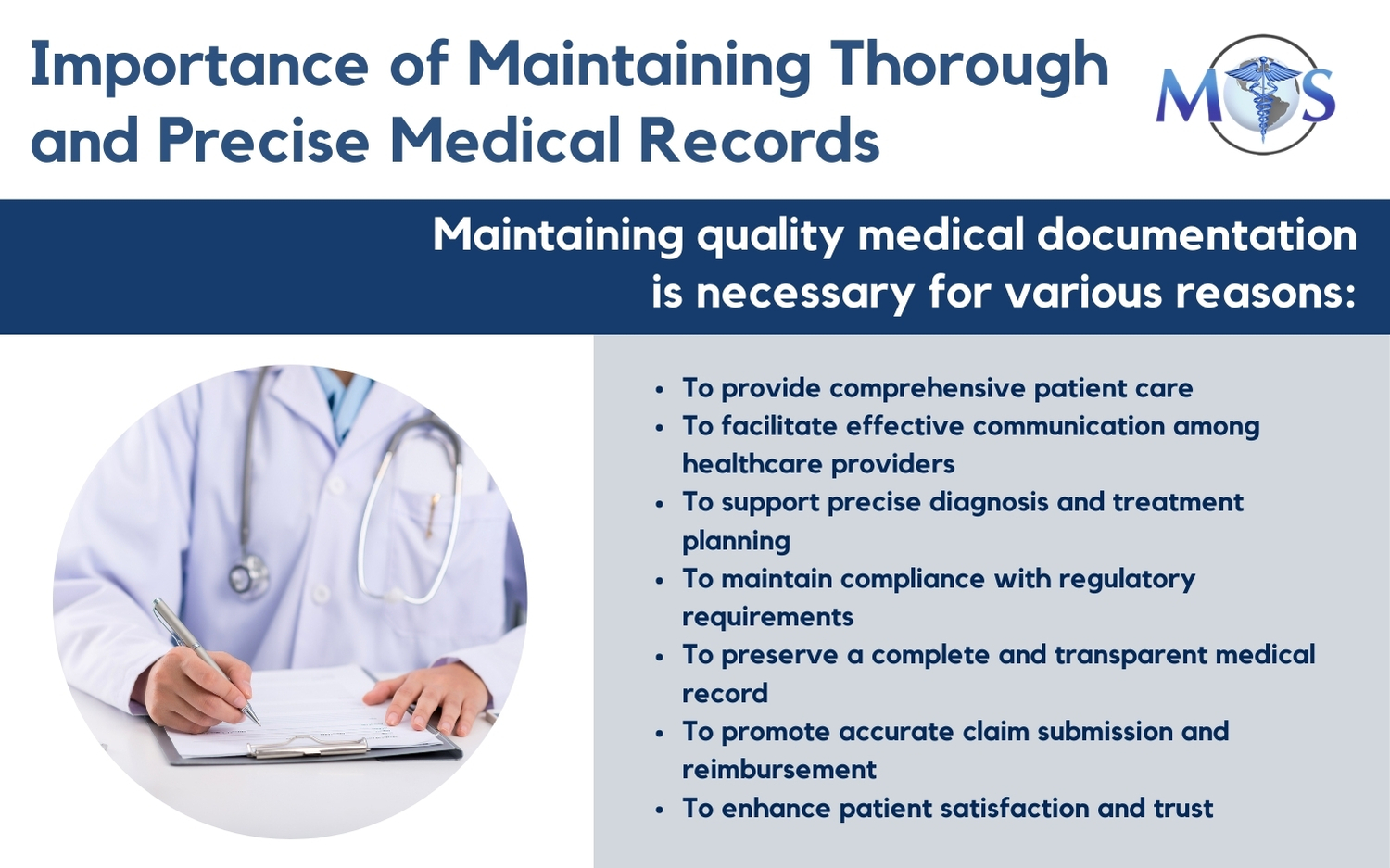
Table of Contents
Accurate and timely medical documentation is essential for delivering high-quality healthcare services and promoting positive patient outcomes. Monitoring and documenting symptoms, diagnoses, drugs, procedures, tests, and examinations provides clinicians with a better understanding of their patient’s health status, allowing for more informed decisions and driving better outcomes. Medical transcription outsourcing is an ideal option to ensure accurate and timely patient charting. Experienced transcriptionists can ensure that all relevant facts, findings, and observations about a patient’s medical history, including past and current illnesses, tests, treatments, and outcomes are accurately entered in the electronic health record (EHR).

Features of Good Clinical Documentation
An article published in Physicians Practice in 2023 listed the key features of good medical documentation as clarity, precision, consistency, timely and measurable. Let’s take a look at each of these aspects:
- Clarity: Clinical documentation should be clear and easily understandable by all healthcare professionals involved in a patient’s care. Ambiguous or vague language can lead to misinterpretation, affecting the quality of care. Clear documentation ensures that all members of the healthcare team can comprehend the patient’s condition, treatment plan, and progress without confusion.
- Precision: Precise clinical documentation would include accurate and specific details about a patient’s condition, treatments, and responses. It ensures that the information recorded is relevant, detailed, and tailored to the individual patient, avoiding generalizations. In addition to proper documentation of the history and the physical exam, all provider-patient communication, including interactions with caregivers, should be documented. Precision minimizes the risk of miscommunication and contributes to better-informed decision-making.
- Consistency: Maintaining a coherent and reliable patient record requires consistency in clinical documentation. Consistency in documentation ensures that anyone reading it gets an accurate and cohesive understanding of the patient’s medical history. Consistency avoids contradictions or discrepancies in information presented consistently across various documents.
- Timely: Prompt recording of data is essential for capturing real-time information about a patient’s condition, interventions, and responses. Timely documentation ensures that healthcare providers have access to the most recent and relevant information, enabling them to make informed decisions and necessary adjustments to the treatment plan.
- Measurable: Measurable documentation includes quantifiable information such as vital signs, laboratory results, medication dosages, or any other parameters. This enhances the objectivity of clinical documentation, allowing healthcare professionals to track changes, assess trends, and monitor the effectiveness of interventions over time.
Best Practices to Improve Medical Documentation Efficiency
Following best practices can make EHR documentation more efficient, contribute to high-quality care, protect healthcare organizations from risk of liability, and also reduce physician burnout.
Team Approach
Increasing team size can improve task efficiency. While medical documentation should be handled by an expert in the field, EMR systems have shifted the process to individual physicians. Medical documentation efficiency can be improved through a team-based approach. Physicians using medical transcription services a scribe or team documentation are more productive, experience less stress, and have more time to focus on patient care. Outsourcing transcription also saves additional staffing costs, while increased productivity allows for more patient visits. In the team approach, physicians can input whatever information they can, and use dictation and transcription services to complete detailed notes.
Staff Education
Effective use of EMRs is crucial for better clinical results. Studies indicate that well-planned training policies and strategies are vital for successful implementation and ongoing utilization of EMR systems. Insufficient training leads to redundant work and suboptimal use of EMRs. For instance, indiscriminate use of the EHR copy-and paste function can lead to serious errors. Educating staff is essential to enhance accuracy and completeness of patient data, ultimately improving efficiency, safety, and quality of patient care.
Reduce Shorthand
Experts advise against shorthand in clinical documentation for several reasons. Using shorthand can introduce ambiguity, risking misinterpretation and potential harm to patient care.
Secondly, shorthand may not be universally understood, hindering communication across specialties or regions. Standardized language enhances comprehension and promotes better communication and care continuity.
Reducing shorthand helps mitigate errors, preventing misinterpretation and confusion that can lead to critical mistakes in patient management. Clear, unambiguous language minimizes risks, ensuring patient safety. Best practice is to use standardized terminologies to describe assessment, identify problems, diagnosis and treatment, outcomes and recommendations
Utilizing Speech Recognition
The use of speech recognition technology can significantly improve medical documentation efficiency. Speech recognition converts spoken words into text, allowing healthcare professionals to dictate and record patient information, diagnoses, and treatment plans in real-time. This eliminates the need for manual data entry, enabling quick and efficient documentation of information by the healthcare provider. It saves time and allows clinicians to focus more on patient care. The technology can be integrated into the medical record. With real-time documentation, providers can capture details during patient encounters seamlessly and correctly, ensuring completeness in patient records. With mobile devices, healthcare professionals can utilize speech recognition tools on-the-go.
However, speech recognition systems come with some drawbacks when it comes to clinical documentation. They may fail to grasp the full context of a conversation and misinterpret spoken words, leading to inaccuracies in medical records. They may also struggle with specialized medical terminology, abbreviations, or acronyms. Furthermore, accents, dialects, or background noise can contribute to errors that may compromise patient information. This can impact the accuracy and completeness of medical records.
Having the machine-generated transcripts reviewed by a HIPAA-compliant US based medical transcription company can optimize the documentation processes, supporting high standards of accuracy and security. Clear, concise documentation provides accurate information for informed decision-making as well as for billing, claim submission, and complete reimbursement.


